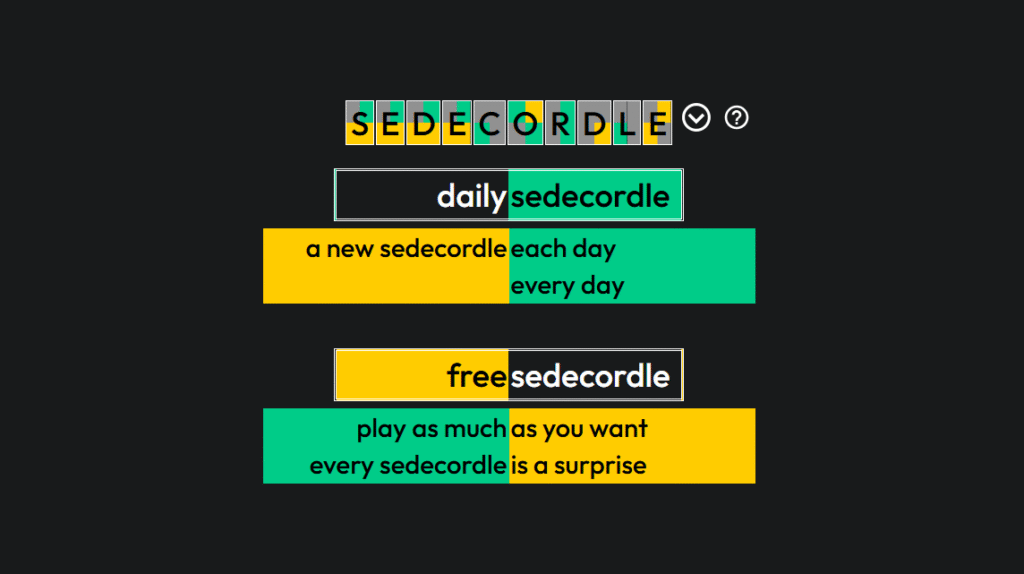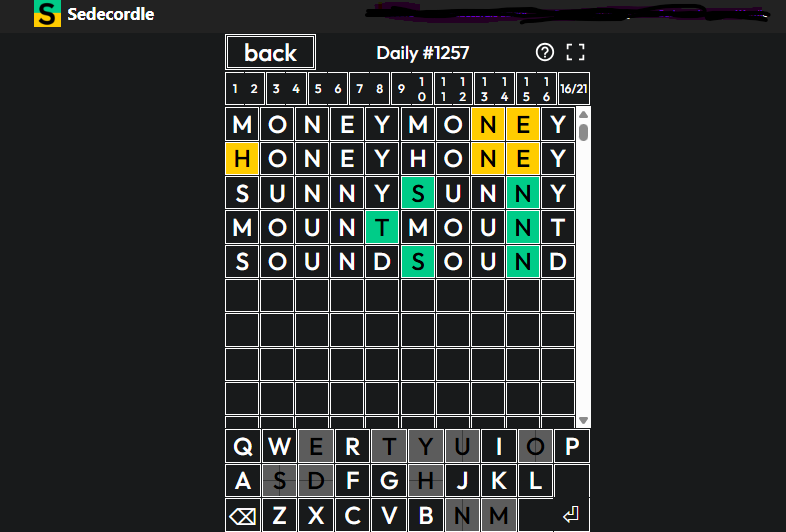The core objective of Sedecordle is deceptively simple: guess all sixteen hidden words within a maximum of twenty-one attempts. Sounds straightforward, right? Well, that’s where the challenge lies. Unlike Wordle, where each guess applies solely to the target word, a single guess in Sedecordle is evaluated against all sixteen puzzles simultaneously. This means you’re essentially playing sixteen Wordle games at once, with the added complexity of untangling the shared feedback across all of them.
How Did It Originate?
Sedecordle, a name cleverly derived from “sedecim” (Latin for sixteen) and “Wordle,” is precisely what it sounds like: a simultaneous battle against sixteen individual Wordle puzzles. Instead of guessing one five-letter word, you’re tasked with deducing sixteen different five-letter words at the same time, all within a limited number of guesses.

Sedecordle Rules
- Each guess is a single word, applied to all 16 puzzles simultaneously.
- Letters turn gray if they are not in any of the words, yellow if they are in at least one word but in the wrong position, and green if they are in the correct word and position.
- You only get feedback for the first word you haven’t solved yet. Once you solve a word, the next one is unlocked and becomes the one receiving feedback.
How to Play Sedecordle?
Don’t be intimidated by the sixteen grids – the core “How to play Sedecordle” mechanics are the same as Wordle, just scaled up.
When you start a Sedecordle game, you’ll be presented with 16 individual Wordle grids. Each grid represents a separate five-letter word you need to guess.
- Your Guess, All Grids: Every word you type and submit will be entered into all sixteen grids simultaneously. This is the crucial difference!
- Color-Coded Feedback: After each guess, the tiles in each of the sixteen grids will change color to provide feedback:
- Green: The letter is correct and in the correct position in that specific word.
- Yellow: The letter is correct but in the wrong position in that specific word.
- Gray: The letter is not in that specific word at all.
- Limited Guesses: You typically have 21 guesses to solve all sixteen words. This might seem like a lot, but remember you’re trying to crack sixteen unique puzzles at once!
- Winning the Game: You win Sedecordle when you successfully guess all sixteen five-letter words within the allotted guesses.
Sedecordle Variations
Daily Sedecordle: A new puzzle is released every day, challenging you to solve all 16 words within the 21-guess limit.
Unlimited Sedecordle: Play as many puzzles as you like, with new random word sets generated for each attempt.
Game Modes: Choose from different word lengths ranging from 4 to 11 letters, depending on your desired difficulty.
Sedecordle Strategy

Conquering Sedecordle requires more than just a good vocabulary; it demands a sophisticated Sedecordle strategy. Here are some essential tips to help you dominate the 16-word challenge:
Smart Starting Words are Crucial
Just like in Wordle, your initial guesses are paramount for gathering information.
Maximize Vowel and Common Consonant Coverage: Choose a starting word (or two) that incorporates a good mix of common vowels (A, E, I, O, U) and frequently used consonants (R, S, T, L, N). Words like “AROSE,” “CRANE,” or “SLATE” are excellent choices. The goal is to gather as much information as possible across all sixteen boards with your early guesses.
Avoid Duplicate Letters: In your first few guesses, try to use words with unique letters to cover more ground, as this provides a wider spread of initial feedback.
Analyze Feedback Systematically
With sixteen grids, it’s easy to get overwhelmed. Develop a system for analyzing the feedback efficiently.
Prioritize Green and Yellow: Focus on the green letters first, as they are locked into position. Then, use yellow letters to narrow down possibilities for words where they appear.
Eliminate Gray Letters Across the Board: Crucially, remember that gray letters are eliminated from all sixteen words. This is where the power of Sedecordle lies – one guess can clear out letters across multiple puzzles, significantly reducing your options.
Group Similarities: Look for patterns. Are several words showing similar letter placements, or missing the same letters? Identifying these commonalities can help inform your next strategic guesses that benefit multiple boards.
The Power of Deductive Reasoning
Sedecordle is a masterclass in deduction.
Hypothesize and Test: Based on the feedback, start forming hypotheses for potential words in various grids. Don’t be afraid to test these hypotheses with your next guesses, even if they only fully solve one or two words. Every solved word frees up mental space.
Focus on Elimination: Sometimes, your best strategy isn’t to guess a correct word, but to guess a word that strategically eliminates many possibilities across multiple boards. This can be more efficient in the long run.
Keep Track: Mentally (or physically, if needed) keep track of which letters you’ve used and their status (green, yellow, gray) in each board.
Don’t Forget the Basics: Vocabulary and Patience
Broaden Your Vocabulary: The more five-letter words you know, the better your chances of quickly identifying solutions.
Patience is a Virtue: You won’t solve all sixteen words in just a few guesses each. It’s a marathon, not a sprint. Take your time, analyze the feedback thoroughly, and make informed decisions rather than rushing.
FAQs
What is Sedecordle?
Sedecordle is an advanced word puzzle game based on the popular Wordle. It challenges players to guess sixteen (16) different five-letter words simultaneously, all within a limited number of attempts. The name comes from “sedecim,” the Latin word for sixteen.
How to play Sedecordle?
AWhen you start Sedecordle, you’ll see 16 separate grids. You enter one five-letter word as a guess, and this word is applied to all sixteen grids. Each grid then provides color-coded feedback (green for correct letter/position, yellow for correct letter/wrong position, gray for not in the word). Your goal is to use this feedback efficiently to deduce all 16 hidden words within 21 guesses.
Is Sedecordle harder than Wordle?
Yes, significantly. Sedecordle requires you to solve sixteen puzzles simultaneously with a limited number of guesses, making it much more challenging and complex than standard Wordle.
Are there different modes?
Yes, there are Daily Sedecordle with a new puzzle every day, Unlimited Sedecordle with random word sets, and various word length options.
How many guesses do you get in Sedecordle?
You typically have 21 guesses to solve all sixteen five-letter words. This might seem like a lot, but remember each guess applies to every board, and you’re aiming to complete 16 separate puzzles.
What’s the best first word for Sedecordle?
Words with a high concentration of common vowels (A, E, I, O, U) and frequently used consonants (R, S, T, L, N) are excellent choices. Examples include “CRANE,” “AROSE,” or “SLATE,” as they provide broad letter information across all sixteen boards.
Are there daily Sedecordle puzzles?
Yes, similar to Wordle, Sedecordle typically offers a new set of sixteen words to solve each day, providing a fresh challenge every 24 hours.
Can I play Sedecordle on my phone?
Yes, Sedecordle websites are generally optimized for mobile browsers, allowing you to play seamlessly on your smartphone or tablet without the need for a dedicated app.
What if I can’t solve all 16 words in 21 guesses?
If you don’t solve all the words within the 21-guess limit, the game ends, and the solutions for the unsolved puzzles are revealed. You can then start a new game the next day.
Does Sedecordle track my stats or progress?
Many Sedecordle websites do track your statistics, such as your win rate, longest streak, and average guesses, allowing you to monitor your improvement over time.
Are there any advanced tips for Sedecordle?
Beyond good starting words, advanced tips include systematically analyzing feedback across all boards, prioritizing greens and yellows, eliminating gray letters from all potential words, and using deductive reasoning to narrow down possibilities for multiple puzzles at once. Focusing on a “process of elimination” strategy can be very effective.